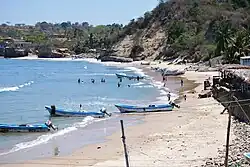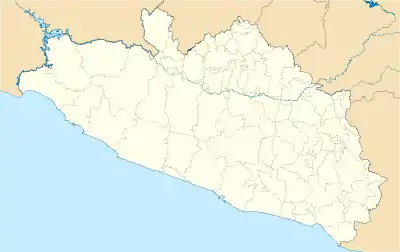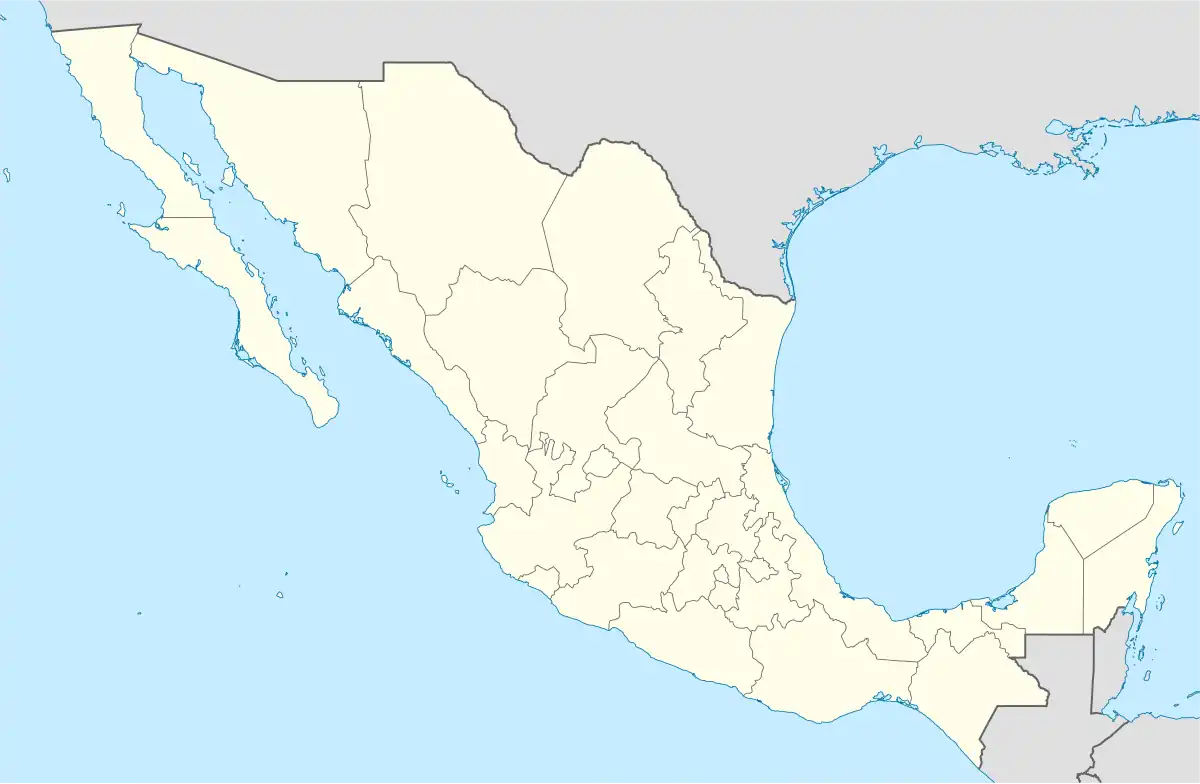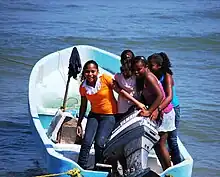San Nicolás | |
|---|---|
 Beach at Punta Maldonado | |
 San Nicolás Location of San Nicolás  San Nicolás San Nicolás (Mexico) | |
| Coordinates: 16°25′N 98°31′W / 16.42°N 98.52°W | |
| Country | |
| State | |
| Incorporated | 21 May 2022 |
| Seat | San Nicolás |
| Area | |
| • Total | 167.22 km2 (64.56 sq mi) |
| Population (2020 Census)[1] | |
| • Total | 6,984 |
| • Density | 42/km2 (110/sq mi) |
| • Seat | 3,249 |
| Time zone | UTC-6 (Central) |
| Postal codes | 41960–41968[2] |
| Area code | 741 |
San Nicolás is a municipality in the Mexican state of Guerrero, located 165 kilometres (103 mi) southeast of the state capital of Chilpancingo. It is named after its patron saint, Nicholas of Tolentino.[3] Its creation from the municipality of Cuajinicuilapa was approved in 2021 and went into force on 21 May 2022.
Geography
The municipality of San Nicolás is located in the Costa Chica region of southeastern Guerrero. It borders the municipality of Cuajinicuilapa in Guerrero to the west, north, and east, the Oaxacan municipality of Santiago Tapextla to the southeast, and the Pacific Ocean to the southwest. The municipality covers an area of 167.22 square kilometres (64.56 sq mi).[1] The municipality's Pacific coast serves as a critical nesting area for the leatherback turtle and is protected as the Ramsar site Playa Tortuguera Tierra Colorada.[4]
San Nicolás has a subhumid temperate climate with rain in the summer. Average temperatures range between 24 and 28 °C (75–82 °F), and average annual precipitation ranges between 1,100 and 1,300 millimetres (43–51 in).[5]
History
The municipality of San Nicolás is located on territory that was once part of the province of Quahuitlán, whose inhabitants spoke Quahteca or Cuahuiteca, which was probably a Mixtec dialect. Quahuitlán which was controlled by Tututepec until around 1497, when the area was conquered by the Mexica Empire. Pedro de Alvarado conquered the area for Spain in 1522, and in 1548 the area was made an encomienda of Tristán de Luna y Arellano.[6] In the late 16th century, Spanish cattle ranchers brought free and enslaved blacks and mulattoes to the area, from whom most of San Nicolás's present-day inhabitants are descended.[7]
In 2004, inhabitants of San Nicolás and nearby communities began an initiative to separate from Cuajinicuilapa and form a new municipality, citing a lack of resources for development in their area.[8] On 31 August 2021 the Guerrero state legislature approved the formation of the municipality of San Nicolás comprising ten localities previously belonging to Cuajinicuilapa.[1] The state constitutional amendment establishing the municipality was passed on 13 January 2022 and went into force on 21 May 2022.[9]
Administration
San Nicolás will hold its first elections as an independent municipality in 2024. The municipal government of San Nicolás will comprise a municipal president, a councillor (Spanish: síndico), and six trustees (regidores).[10]
Demographics and culture

In the 2020 Mexican Census, the localities that now comprise the municipality of San Nicolás recorded a population of 6984 inhabitants.[1] The municipal seat, also named San Nicolás, recorded a population of 3249 inhabitants in the 2020 Census.[1] The next most populous localities are La Pitahaya and Punta Maldonado, which recorded populations of 1583 and 848 inhabitants respectively in the 2020 Census.[11][12]
Like the neighbouring Cuajinicuilapa, San Nicolás has been identified by cultural authorities, academics, and journalists as a centre of Afro-Mexican culture in Guerrero's Costa Chica. However, residents of San Nicolás self-identify as moreno (black Indians) and reject labels such as "black", "Afromexican" and "Afromestizo". Since the late 1990s, a significant community of expatriates from San Nicolás has lived in the cities of Winston-Salem, Greensboro and Charlotte in North Carolina.[7]
Economy
The economy of San Nicolás is based on smallholder farming: farmers grow corn for their own consumption, and sesame and fruit (e.g., mango, papaya and watermelon) for sale to regional markets. Seaside communities depend heavily on fishing.[13]
References
- 1 2 3 4 5 6 "DECRETO NÚMERO 862, MEDIANTE EL CUAL SE CREA EL MUNICIPIO DE SAN NICOLÁS, GUERRERO" (PDF) (in Spanish). Congress of Guerrero. 31 August 2021. Retrieved 24 November 2023.
- ↑ "Consulta de Códigos Postales". Catálogo Nacional de Códigos Postales. Mexican Postal Service. 23 November 2023. Retrieved 24 November 2023.
- ↑ Lewis, Laura A. (February 2001). "Of Ships and Saints: History, Memory, and Place in the Making of Moreno Mexican Identity". Cultural Anthropology. 16 (1): 62–82. JSTOR 656602.
- ↑ "Playa Tortuguera Tierra Colorada". Ramsar Sites Information Service. Ramsar Convention. 27 November 2003. Retrieved 24 November 2023.
- ↑ "Cuajinicuilapa, Guerrero" (PDF). Prontuario de información geográfica municipal de los Estados Unidos Mexicanos (in Spanish). INEGI. 2009. Retrieved 24 November 2023.
- ↑ "Quahuitlán, Provincia de". Enciclopedia Guerrerense. 11 March 2020. Retrieved 24 November 2023.
- 1 2 Lewis, Laura A. (2012). Chocolate and Corn Flour: History, Race, and Place in the Making of “Black” Mexico. Duke University Press. pp. 2–4. doi:10.1215/9780822394778. ISBN 978-0-8223-9477-8.
- ↑ Contreras Lara, Juan José (30 July 2014). "Promueven la creación de un nuevo municipio en Costa Chica". Quadratín Guerrero (in Spanish). Retrieved 25 November 2023.
- ↑ "DECRETO NÚMERO 161 POR EL QUE SE APRUEBA LA ADICIÓN DE LOS NUEVOS MUNICIPIOS DE SANTA CRUZ DEL RINCÓN, SAN NICOLÁS, ÑUU SAVI Y LAS VIGAS AL ARTÍCULO 27 DE LA CONSTITUCIÓN POLÍTICA DEL ESTADO LIBRE Y SOBERANO DE GUERRERO. EN EL LUGAR QUE CONFORME AL ORDEN ALFABÉTICO LES CORRESPONDE" (PDF). Periódico Oficial del Estado de Guerrero (in Spanish). 20 May 2022. pp. 9–24. Retrieved 21 November 2023.
- ↑ Chávez, Lourdes (16 November 2023). "Aprueba IEPC composición de ayuntamientos, incluidos los cuatro nuevos municipios". El Sur (in Spanish). Chilpancingo. Retrieved 24 November 2023.
- ↑ "El Pitahayo, Cuajinicuilapa, Guerrero (120230036)". México en Cifras (in Spanish). INEGI. Retrieved 24 November 2023.
- ↑ "Punta Maldonado (El Faro), Cuajinicuilapa, Guerrero (120230022)". México en Cifras (in Spanish). INEGI. Retrieved 24 November 2023.
- ↑ Lewis, Laura A. (November 2000). "Blacks, Black Indians, Afromexicans: The Dynamics of Race, Nation, and Identity in a Mexican "moreno" Community (Guerrero)". American Ethnologist. 27 (4): 898–926. JSTOR 647400.
Further reading
- Solís Téllez, Judith (September 2017). Afromexicanos: San Nicolás de Tolentino y Cuajinicuilapa, Guerrero (in Spanish). Mexico: Ediciones y Gráficos Eón, Autonomous University of Guerrero. ISBN 978-607-8559-08-4.